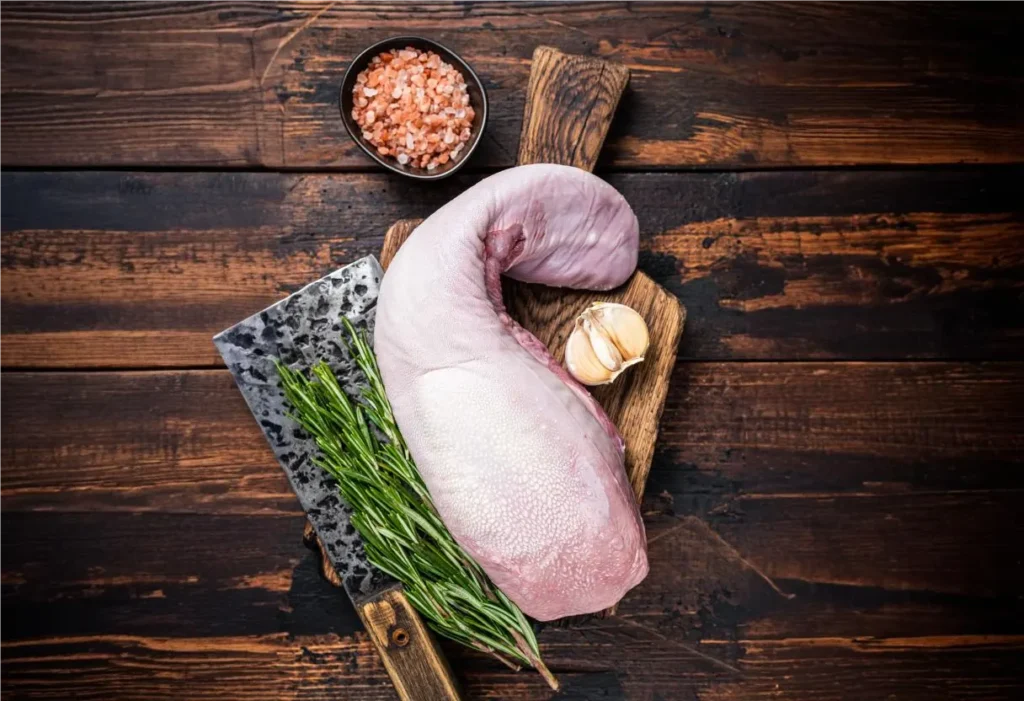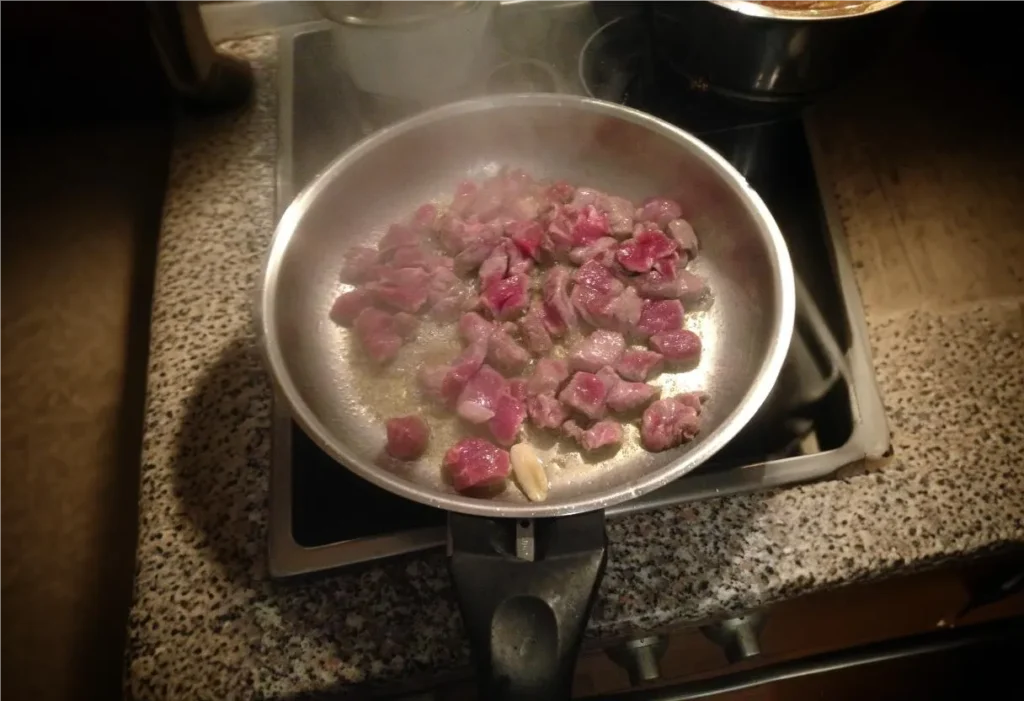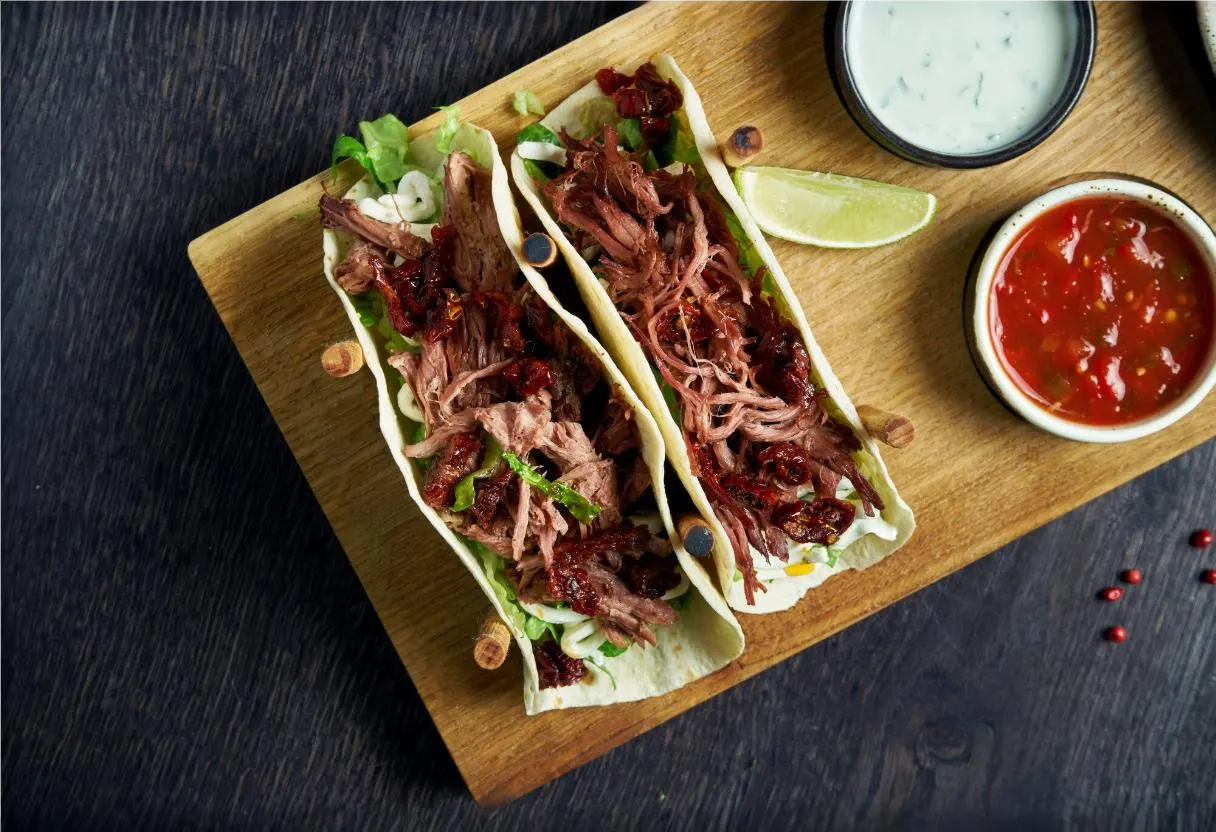Explore the history, flavor, and step-by-step cooking tips for Tacos de Lengua in this all-inclusive guide, guaranteed to inspire your kitchen.
Introduction
Tacos de Lengua—also known as beef tongue tacos—are deeply rooted in Mexican culinary tradition, bringing together bold flavors, tender textures, and a sense of heritage that resonates with food lovers. Many people in the United States have recently discovered these delicious tacos and now seek to recreate them at home. Although some may feel hesitant about using beef tongue, the result is a dish that is remarkably juicy, rich, and uniquely satisfying.
Indeed, this article will give you the confidence to prepare authentic Tacos de Lengua in your own kitchen. Throughout this guide, we will cover everything from historical origins and cultural significance to cooking techniques and tasty topping ideas. In addition, we will address nutritional insights and provide a detailed recipe outline. Therefore, get ready to embark on a culinary journey that will open your eyes to the versatility and depth of flavor that Tacos de Lengua have to offer.
If you are a fan of bold Latin-inspired dishes, you might also want to explore our Mexican Beef Stew: Authentic Flavors and our Authentic Molcajete Salsa Recipe for more hearty Mexican fare.
In the sections that follow, we will delve into the many facets of Tacos de Lengua. From understanding the historical context that shaped this cherished dish to learning how to properly source and prepare beef tongue, you will discover a comprehensive approach that empowers you to create an authentic plate. Furthermore, this guide will highlight how to pair Tacos de Lengua with classic or modern toppings, ensuring that your kitchen becomes a hub of mouthwatering aromas and bold flavors.
- Introduction
- Historical and Cultural Significance
- Understanding Beef Tongue
- Traditional Preparation Methods
- Step-by-Step Tacos de Lengua Recipe
- Delicious Toppings & Serving Suggestions
- Regional Variations
- Modern Twists & Fusion Ideas
- Nutritional Insights and Health Benefits
- Frequently Asked Questions
- Conclusion
Historical and Cultural Significance
The Roots of Tacos de Lengua
Before you start cooking, it helps to understand the fascinating backstory behind Tacos de Lengua. Traditionally, many Mexican recipes emerged from the need to utilize every part of the animal. Beef tongue, or lengua, was no exception. Given that no portion went to waste, Mexican cooks developed ingenious methods to transform this cut into something delicious and comforting.
Through generations, Tacos de Lengua have represented resourcefulness, respect for the animal, and a profound appreciation for robust flavors. As the dish gained popularity, it traversed borders and gradually appeared in restaurants and taco trucks all across the United States. Today, you can find Tacos de Lengua on menus of both humble eateries and upscale establishments, reflecting its widespread appeal.
Tacos de Lengua in the U.S.
Tacos de Lengua started showing up in many U.S. cities decades ago, thanks in large part to Mexican-American communities that introduced this unique delicacy to new audiences. Initially, these tacos were mostly enjoyed in areas with strong Latin influences—particularly in places like Los Angeles, Houston, and Chicago. However, as word spread about the tender consistency and bold flavor of beef tongue, more foodies became eager to try it.
Nowadays, Tacos de Lengua are recognized as a prized option on diverse taco menus, bridging cultural gaps and encouraging more people to experiment with lesser-known cuts of beef. Therefore, these tacos serve as an excellent illustration of how culinary traditions can spread, adapt, and flourish in new environments.
Understanding Beef Tongue
Anatomy and Texture
Beef tongue is an often-overlooked cut that offers a tender, melt-in-your-mouth texture when cooked properly. Although some may be apprehensive about cooking with organ meat, beef tongue is actually a muscle with a distinctive structure. When you first pick it up from the butcher, you may notice its thick, outer membrane—this needs to be trimmed off after cooking. Underneath lies delicate meat that becomes incredibly soft and juicy after hours of slow cooking.
Consequently, once you bite into a perfectly cooked slice, you will discover that the savory juices burst in your mouth. This deep, comforting quality easily rivals other popular taco fillings such as carne asada or carnitas. Because of the unique consistency, beef tongue responds well to intense seasonings, soaking them in over the course of the cooking process.
Flavor Profile
Unlike more familiar cuts of beef that sometimes risk drying out if overcooked, beef tongue remains succulent. It imparts a robust, mouth-filling taste—almost akin to pot roast, yet slightly more concentrated. This pleasant richness pairs beautifully with brightly flavored toppings like onions, cilantro, and salsas. Therefore, when you serve Tacos de Lengua, you can count on a balance of hearty and fresh elements coming together in every bite.
Sourcing and Selection
Finding a high-quality beef tongue can make a significant difference in your final dish. Large grocery stores often carry it in the butcher section, but if you do not see it, consider speaking directly to the butcher or visiting a specialized Latino market. Ethically sourced, fresh beef tongue often yields a better texture and less of a “gamey” scent. Furthermore, you can compare sizes: smaller tongues are typically more tender, while larger ones may require longer cook times.
Traditional Preparation Methods
Cleaning and Prepping
Before you can begin cooking, give yourself enough time to rinse and clean the beef tongue thoroughly. Rinse it under cold water and remove any visible impurities. Then, pat it dry with paper towels. You do not have to remove the tough, outer skin at this stage because it peels off more easily after cooking. However, be sure to trim off any extra fat or glands around the base of the tongue if you see them.
In addition, it helps to flavor the tongue with aromatics such as onion, garlic, and bay leaves before or during cooking. These seasonings penetrate the meat, ensuring that each slice has a balanced flavor profile.
Braising Techniques
Braising is arguably the most common cooking method for Tacos de Lengua. By submerging the tongue in a flavorful liquid—often a mix of water, broth, or stock—along with aromatics, you give the meat ample time to tenderize. Many cooks prefer using a large stockpot, but a pressure cooker or slow cooker can also be excellent alternatives.
- Stockpot (Stovetop Method): Combine tongue, onions, garlic cloves, and a few bay leaves in water or broth. Bring the mixture to a gentle simmer and maintain it for two to three hours, or until the meat is fork-tender.
- Pressure Cooker: Place similar ingredients in the cooker. Seal and cook on high pressure for about 40–50 minutes, depending on the size of the tongue. Natural release helps preserve moisture.
- Slow Cooker: Set on low and cook for about six to eight hours, or until the meat feels soft. You can sear the tongue beforehand for extra flavor.
In each method, the key is to achieve a thoroughly cooked, tender result. Therefore, keep a close eye on cooking times and test for doneness by gently prodding the tongue with a fork or knife.
Grilling or Crisping
After braising, some enthusiasts like to slice the tongue and give it a quick sear on a hot griddle or skillet. This step adds an appealing exterior crisp. First, remove the membrane and slice the meat into half-inch pieces. Then, heat a small amount of oil in a skillet over medium-high heat. Place the slices in the pan and let them sizzle until they develop a slight golden crust. This quick sear does not take long—just a couple of minutes on each side—but the result is an extra layer of flavor.
Step-by-Step Tacos de Lengua Recipe

Below is a user-friendly approach to creating Tacos de Lengua from scratch. The process can seem time-consuming at first. However, once you taste these tacos, you will quickly realize that each step is worth the effort.
Ingredients Needed
- 1 beef tongue (approximately 2–3 pounds)
- 6 cups water or beef broth (enough to fully submerge the tongue)
- 1 medium onion, halved
- 4 garlic cloves
- 2 bay leaves
- 1 teaspoon black peppercorns
- 2 teaspoons salt (adjust to taste)
- 1 teaspoon ground cumin (optional)
- 8–10 corn tortillas (soft, warm)
- 1 tablespoon cooking oil (for searing)
Toppings (optional but highly recommended):
- Chopped white onion
- Fresh cilantro, chopped
- Salsa (verde or roja)
- Lime wedges
Cooking Equipment
- Large stockpot, pressure cooker, or slow cooker
- Skillet or griddle for optional searing
- Knife and cutting board
- Tongs
- Serving plates
Expanded Step-by-Step Instructions

- Rinse and Clean: Rinse the beef tongue thoroughly under cold water to remove any debris. Pat it dry with paper towels.
- Initial Seasoning: Place the tongue in your cooking vessel of choice. Add water or beef broth until the meat is just submerged. Include onion, garlic cloves, bay leaves, black peppercorns, salt, and (optionally) ground cumin.
- Cooking Method:
- Stockpot: Bring to a gentle simmer, cover partially, and cook for about 2–3 hours.
- Pressure Cooker: Seal and set on high pressure for 40–50 minutes. Use natural release for 10–15 minutes.
- Slow Cooker: Place on low for 6–8 hours, or on high for about 4 hours, checking tenderness occasionally.
- Check Doneness: Test the meat by piercing it with a fork or slicing into the thickest area. If it offers little resistance, it is done.
- Cool and Peel: Carefully remove the tongue from the cooking liquid. Let it cool for a few minutes. When it is manageable, peel off the tough, outer membrane. Trim away any fatty sections if desired.
- Slice: Cut the tongue into roughly half-inch slices. Adjust thickness based on preference.
- Optional Sear: Heat a tablespoon of cooking oil in a skillet over medium-high heat. Place the slices in the pan. Sear each side for 1–2 minutes until lightly browned.
- Tortilla Prep: Warm your corn tortillas on a griddle or in a dry skillet to make them pliable and aromatic.
- Assemble Tacos: Fill each tortilla with slices of beef tongue. Top with chopped onions, cilantro, and your favorite salsa. Add a squeeze of lime to brighten the flavor.
Note: This recipe yields enough for about eight to ten tacos, depending on portion sizes. If hosting a larger gathering, adjust the quantities accordingly.
Tips for Perfection
- Seasoning the Broth: Feel free to experiment with additional spices like oregano, chili powder, or even a pinch of cloves.
- Tortilla Warmth: Keep your tortillas soft by wrapping them in a clean kitchen towel or foil after heating.
- Avoid Overcooking: While it is hard to overcook beef tongue during braising, searing slices too long can dry them out. Watch carefully to maintain tenderness.
Delicious Toppings & Serving Suggestions
Classic Toppings
When it comes to Tacos de Lengua, the simplest toppings often shine the most. Diced onions and chopped cilantro provide a fresh contrast to the deep, meaty flavor of the tongue. A squeeze of lime juice balances the richness, brightening every bite. Therefore, embrace these staples to create an authentic taco experience.
Salsa & Sauces
To further enhance taste, consider experimenting with different salsas:
- Salsa Roja: A blend of tomatoes, chili peppers, and spices.
- Salsa Verde: Features tangy tomatillos.
- Pico de Gallo: Offers a burst of freshness with tomatoes, onions, cilantro, and jalapeños.
Additionally, you can top your tacos with a spoonful of guacamole for added creaminess, or drizzle on a tangy hot sauce if you crave extra heat. Each combination can give your Tacos de Lengua a unique character.
Presentation & Meal Pairings
For a full Mexican-inspired meal, serve your Tacos de Lengua alongside refried beans or Mexican rice. You could also complement the tacos with a simple green salad, grilled vegetables, or black beans. In fact, many side dishes commonly found in Mexican cuisine work beautifully to round out the plate.
If you are looking for more ideas to expand your Latin-inspired menu, check out our Homemade Taco Bowl Recipe for a convenient and festive way to serve a variety of Mexican-inspired ingredients.
Regional Variations
Northern Mexican Variations
In border states like Chihuahua or Nuevo León, Tacos de Lengua might use flour tortillas instead of corn. While corn is still the norm for many families, flour tortillas can bring a slightly different taste and texture. Moreover, some northern cooks incorporate chile colorado (a red chili sauce) during the braising stage, infusing the meat with a smoky spice.
Southern Mexican Variations
In the central and southern regions of Mexico, you may find different herb blends or marinades. For instance, some recipes feature achiote (annatto) paste, giving the tongue a subtle, earthy sweetness. Others might garnish Tacos de Lengua with pickled onions or a unique chili-based salsa that reflects local flavors. Thus, while the core concept remains the same, local traditions can provide delightful twists.
Modern Twists & Fusion Ideas
American Fusion Creations
For those who love experimenting, adding barbecue seasonings or Cajun spices can bring a new dimension. Some restaurants mix crispy fried onions or shredded cheese into their Tacos de Lengua, melding Mexican flair with American comfort foods. Therefore, if you enjoy pushing culinary boundaries, do not hesitate to incorporate your favorite flavors.
Upscale Presentations
Upscale restaurants might serve small, refined portions of seared lengua on handcrafted tortillas. These gourmet variations often come with artisanal sauces or exotic salsas, elevating Tacos de Lengua to a fine-dining level. Although more elaborate, these modern takes still honor the core principle of properly cooked, tender beef tongue.
Nutritional Insights and Health Benefits
Although beef tongue can appear intimidating, it provides a range of nutrients when enjoyed in moderation. Let us take a closer look.
Nutritional Content (per 100g)
| Nutrient | Approx. Value | % Daily Value |
|---|---|---|
| Calories | 223 kcal | 11% |
| Protein | 17 g | 34% |
| Fat | 16 g | 20% |
| Saturated Fat | 7 g | 35% |
| Carbohydrates | 0 g | 0% |
| Sodium | 72 mg | 3% |
| Iron | 2.2 mg | 12% |
| Vitamin B12 | 3.8 µg | 158% |
Values based on approximate averages and may vary depending on cooking methods and seasoning.
Because beef tongue is high in protein, it can be a valuable element of a balanced diet. However, it also contains significant amounts of fat and cholesterol, so consider portion sizes accordingly. Adding fresh vegetables and salsa further enhances the nutritional profile of your tacos.
Frequently Asked Questions
Is Tacos de Lengua Cow Tongue?
Yes, Tacos de Lengua are made with beef tongue. Preparing and seasoning cow tongue results in tender, flavorful meat, perfect for tacos.
Are Tacos de Lengua Healthy?
Tacos de Lengua can be part of a healthy diet when eaten in moderation. They are a good source of protein and essential vitamins like B12. However, beef tongue also contains notable amounts of saturated fat. Balancing Tacos de Lengua with vegetables and fresh toppings can support a nutritious meal.
What Are Tacos Made Of?
Tacos typically consist of a tortilla filled with a protein source—like beef, chicken, or fish—along with garnishes such as onions, cilantro, and various salsas. When it comes to Tacos de Lengua specifically, the primary protein is slow-cooked beef tongue.
Additional FAQs
How do I store and reheat leftover Tacos de Lengua?
- Store leftover cooked tongue slices in an airtight container in the refrigerator for up to three days. Reheat gently in a skillet with a little oil or in the microwave at half-power to preserve tenderness.
Can I substitute beef tongue with other cuts?
- If you do not have beef tongue, you could try slow-cooked beef cheeks or shredded beef chuck roast. They will have a different texture, but the flavor can still be delicious.
What if I want a vegetarian option?
- If you prefer a meatless version, you can fill tortillas with seasoned mushrooms or jackfruit to mimic the tender mouthfeel while keeping them plant-based.
If you are curious about more hearty beef-based recipes, you might also enjoy our guides on Beef Tamales: Ingredients & Preparation or Traditional Beef Tamales Recipe for another rich and satisfying Mexican dish.
Conclusion
By now, you have discovered the magic of Tacos de Lengua, from their cultural importance to the step-by-step process of cooking and assembling. Although this dish may challenge some preconceptions, exploring beef tongue as a taco filling rewards you with an unparalleled depth of flavor and luxurious texture. Therefore, we encourage you to give it a try in your own kitchen.
Always remember to season the cooking broth generously, slice your lengua properly, and consider a brief sear for a crisp exterior. Top your tacos with onion, cilantro, and lime for a straightforward yet unforgettable meal. In addition, feel free to experiment with fresh salsas and sauces to customize your tacos. Overall, Tacos de Lengua have the power to wow your friends, family, and anyone seeking to expand their culinary horizons.
For more exciting cooking tips and recipes, check out our in-depth articles like Egg White Frittata Recipe or Pea Pasta Recipe to diversify your meal planning. We hope this guide inspires you to embrace authentic flavors while making your kitchen a place for exploration and enjoyment.

